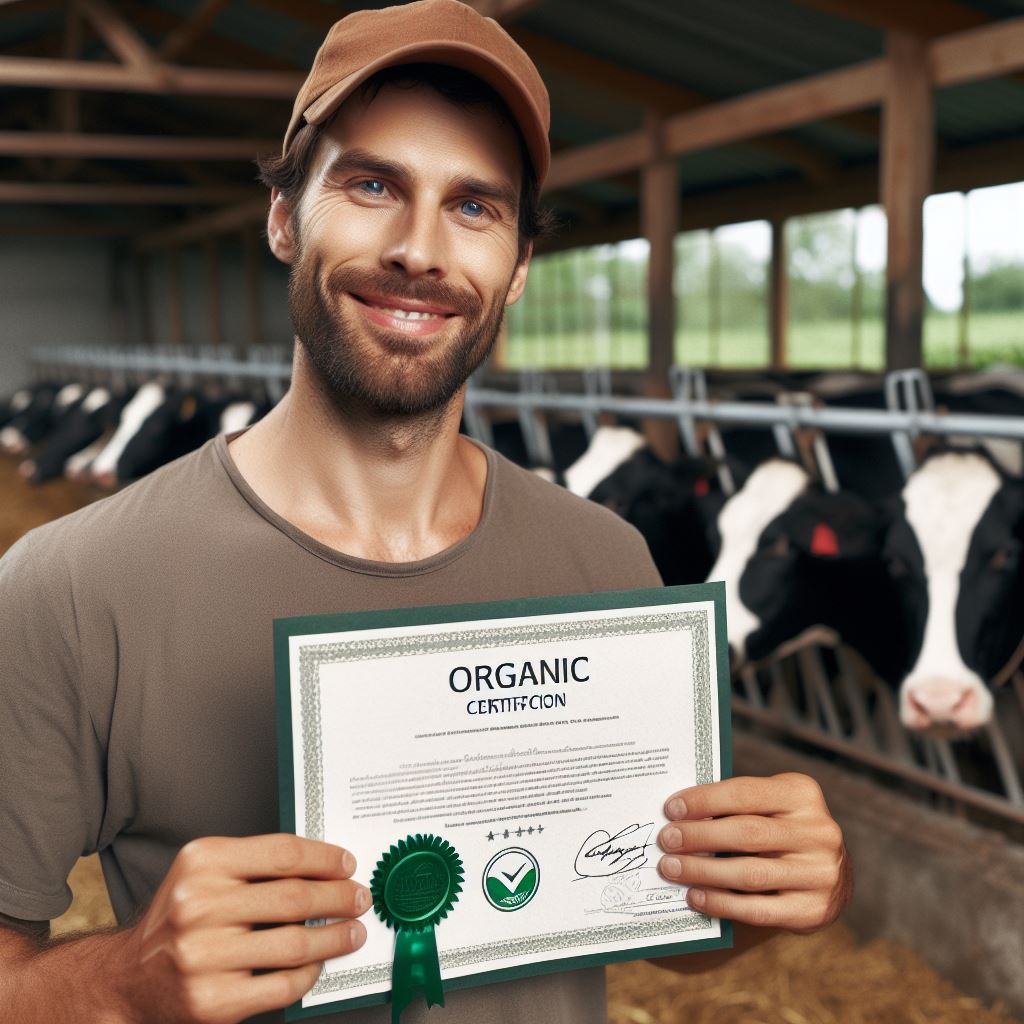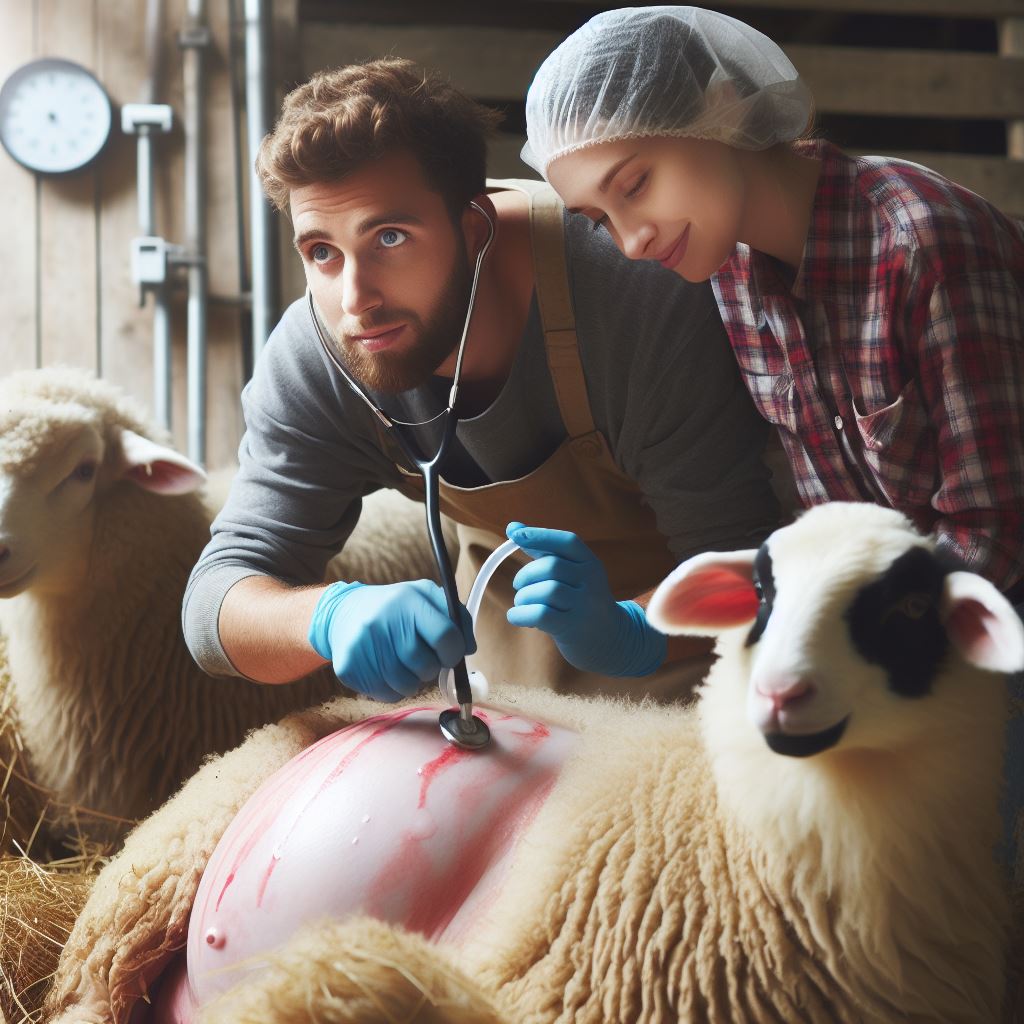Introduction
Dive into the world of organic wool production, driven by sustainable and eco-friendly practices.
Explore a holistic approach that respects animal welfare, environmental health, and the quality of the final product.
Understand the rising consumer demand for ethically produced wool, reflecting a shift towards conscious and responsible choices.
Delve into the stringent certification standards ensuring adherence to organic and humane wool production practices.
Discover how organic wool production can be a profitable venture while aligning with ethical and environmental values.
Embark on a journey where sustainability meets quality, as we unravel the essentials of thriving in organic wool production.
What is Organic Wool?
Definition and characteristics of organic wool
- Organic wool refers to wool that is produced following strict organic standards.
- It is obtained from sheep that are raised on organic farms without the use of synthetic chemicals.
- The wool is free from any chemical residue and has minimal environmental impact.
- Organic wool is known for its exceptional softness, warmth, and breathability.
- It is naturally hypoallergenic and is suitable for people with sensitive skin.
Organic standards and certifications for wool
- To be considered organic, wool must meet certain criteria set by organic certification bodies.
- Organic standards ensure that the sheep are not exposed to synthetic pesticides, hormones, or antibiotics.
- The sheep must be grazed on organic pastures and receive organic feed if required.
- Organic wool production also prohibits mulesing, a practice that can cause distress to sheep.
- Certifications like GOTS (Global Organic Textile Standard) and OCS (Organic Content Standard) guarantee the authenticity of organic wool.
Benefits of organic wool over conventional wool
- Organic wool production promotes sustainable and eco-friendly farming practices.
- It reduces the exposure of farmers, animals, and consumers to harmful chemicals.
- Organic wool has a lower carbon footprint compared to conventional wool.
- It helps to preserve biodiversity by avoiding the use of synthetic pesticides that harm beneficial insects.
- Organic wool is also biodegradable, reducing the environmental impact once it is no longer in use.
In general, organic wool is a responsibly produced fiber that offers numerous advantages over conventional wool.
Its definition and characteristics highlight its purity, softness, and suitability for individuals with sensitivities.
The strict adherence to organic standards and certifications ensures the integrity of the product.
By choosing organic wool, consumers contribute to a more sustainable and healthier textile industry.
Read: Essential Goat Breeds for American Farmers
Getting Started with Organic Wool Production
In order to establish a successful organic wool production system, there are several important steps to follow.
This section will guide you through the initial stages of getting started with organic wool production.
Selecting suitable sheep breeds for organic wool
- Start by researching and identifying sheep breeds that are well-suited for organic wool production.
- Look for breeds that have a dense and crimped fleece, as these characteristics make the wool more valuable.
- Consider the local climate and terrain when choosing sheep breeds, as certain breeds thrive in specific conditions.
- Breeds like Merino, Rambouillet, and Corriedale are known for their high-quality wool and adaptability to organic farming.
The first step is selecting suitable sheep breeds for organic wool production.
Research and identify breeds that have dense and crimped fleeces, as they tend to yield higher-quality wool.
Transform Your Agribusiness
Unlock your farm's potential with expert advice tailored to your needs. Get actionable steps that drive real results.
Get StartedConsider the local climate and terrain to choose breeds that are well-adapted to your specific farming conditions.
Popular sheep breeds for organic wool production include Merino, Rambouillet, and Corriedale.
Preparing the land for organic sheep farming
- Conduct a soil test to determine the quality and suitability of the land for organic sheep farming.
- Eliminate the use of synthetic fertilizers, pesticides, and herbicides on the land to meet organic farming standards.
- Implement sustainable land management practices such as crop rotation and cover cropping to improve soil fertility.
- Ensure the land has ample pasture area, clean water sources, and proper fencing for the sheep’s grazing and protection.
Once you have selected the appropriate sheep breeds, it is crucial to prepare the land for organic sheep farming.
Conduct a soil test to assess its fertility and suitability for organic farming.
Avoid using synthetic fertilizers, pesticides, and herbicides as they are prohibited in organic production.
Implement sustainable land management practices such as crop rotation and cover cropping to improve soil health and fertility.
Adequate pasture area, clean water sources, and proper fencing are also essential for the well-being and safety of the sheep.
Understanding and fulfilling organic wool production requirements
- Familiarize yourself with the organic wool production standards set by organic certifying agencies.
- Provide a healthy diet consisting of organic pasture, hay, and grains, avoiding GMOs and synthetic additives.
- Treat any illnesses or parasites using organic-approved methods, such as herbal remedies or essential oils.
- Keep detailed records of all management practices, feed sources, and veterinary treatments for organic certification requirements.
To meet organic wool production requirements, you must understand and fulfill the standards set by organic certifying agencies.
Familiarize yourself with the specific regulations and guidelines for organic wool production.
Provide a diet consisting of organic pasture, hay, and grains to ensure the sheep’s health and well-being.
Avoid genetically modified organisms (GMOs) and synthetic additives in their feed.
When treating illnesses or parasites, use organic-approved methods such as herbal remedies or essential oils.
Keeping detailed records of all management practices, feed sources, and veterinary treatments is necessary for organic certification.
Essentially, starting an organic wool production system requires careful selection of suitable sheep breeds, proper land preparation, and adherence to organic wool production requirements.
By following these guidelines, you can lay a solid foundation for a successful organic wool farming operation.
Read: Managing Goat Health: Essential Tips
Organic Feed and Grazing Practices
Importance of organic feed for sheep
Sheep require a balanced diet to maintain their health and produce high-quality wool.
Organic feed is crucial to ensure that sheep receive the necessary nutrients and minerals.
It helps in preventing nutritional deficiencies and improves overall well-being and resistance to diseases.
Organic feed also eliminates the risk of pesticide residue contamination in the wool.
Types of organic feed suitable for organic wool production
- Pasture forage: Organic pasture is a natural and abundant source of essential nutrients for sheep. It includes a variety of grasses, legumes, and herbs that provide a balanced diet. Certified organic pasture ensures no synthetic fertilizers, pesticides, or GMOs are used.
- Organic hay: High-quality organic hay is a great source of roughage and fiber for sheep. It should be free from chemical fertilizers, herbicides, and pesticides. Different types of hay can be used, such as timothy, clover, or alfalfa, depending on nutritional requirements.
- Organic grain: Grains like barley, oats, and corn can supplement a sheep’s diet. Certified organic grains are free from genetically modified organisms and pesticides. They provide energy and help in meeting the nutritional needs of sheep during various stages of production.
Organic grazing methods and rotational grazing practices
- Managed grazing: It involves controlling sheep’s access to pasture to ensure optimal utilization. Managed grazing prevents overgrazing and allows the forage to regrow for continuous supply. It also prevents soil erosion and helps maintain a healthy ecosystem on the farm.
- Rotational grazing: This method involves dividing the pasture into several paddocks. Sheep rotate between these paddocks, allowing rest and regrowth of grazed areas. Rotational grazing promotes even grazing, prevents selective foraging, and improves forage utilization.
- Silvopasture: This innovative practice combines trees, forage, and livestock. Introducing trees in pastures provides shade, shelter, and additional forage options for sheep. Silvopasture reduces the reliance on external feed sources and enhances the overall health of the animals.
- Multi-species grazing: Co-grazing sheep with other livestock, such as cattle or goats, offers several benefits. Different animals have different grazing preferences, leading to better forage utilization. Additionally, different species graze at different heights, helping maintain a diverse and healthy pasture ecosystem.
Generally, organic feed and grazing practices are vital for organic wool production.
Providing sheep with organic feed ensures their nutritional needs are met without the use of harmful chemicals.
Implementing proper grazing methods promotes sustainable land management and enhances the overall productivity of the farm.
By prioritizing organic feed and embracing responsible grazing practices, producers can ensure the production of high-quality organic wool.
Showcase Your Farming Business
Publish your professional farming services profile on our blog for a one-time fee of $200 and reach a dedicated audience of farmers and agribusiness owners.
Publish Your ProfileRead: Sheep Health Care Basics for Farmers
Animal Welfare and Health in Organic Wool Production
Ensuring proper access to pasture and shelter for sheep
- Sheep in organic wool production systems must have regular access to pasture to graze.
- Providing adequate shelter is essential to protect sheep from harsh weather conditions.
- These measures promote the overall well-being of the animals, reducing stress and ensuring their happiness.
- Healthy sheep produce better quality wool, making it crucial to prioritize their welfare.
By prioritizing animal welfare and health, organic wool production contributes to sustainable and ethical farming practices.
Sheep have the opportunity to lead natural lives, grazing in open pastures and finding shelter when needed.
This freedom of movement and access to pasture promotes their physical and mental well-being.
Organic methods for disease prevention and treatment in sheep
- Preventing diseases is key in organic wool production, as synthetic medicines are prohibited.
- Implementing good flock management practices minimizes the risk of diseases spreading.
- This includes regular monitoring of sheep’s health, proper nutrition, and hygiene.
- In case of illness, organic farmers resort to natural remedies instead of antibiotics or chemical treatments.
Organic farmers prioritize disease prevention in their flocks through good management practices.
Regular health check-ups, balanced nutrition, and a clean environment are essential aspects of holistic sheep care.
By avoiding synthetic medications, organic farmers promote the development of natural resistance in sheep populations.
Avoidance of harmful chemicals and medications
- Organic wool production prohibits the use of harmful chemicals, such as pesticides.
- Sheep are not exposed to pesticides, which can have detrimental effects on their health.
- Additionally, synthetic growth hormones and genetically modified organisms (GMOs) are strictly prohibited.
- Alternative methods are used to control pests and weeds, ensuring the sustainability of the ecosystem.
One of the main advantages of organic wool production is the avoidance of harmful chemicals and medications.
Sheep are not exposed to pesticides, reducing their risk of illness.
The absence of synthetic growth hormones and GMOs ensures that animals are not subjected to unnatural genetic modifications or artificial substances.
Organic farmers employ alternative methods to control pests and weeds, relying on environmentally friendly practices.
These methods include crop rotation, biological pest control, and maintaining a healthy balance in the ecosystem.
By avoiding the use of harmful chemicals, organic wool production benefits not only the sheep but also the surrounding environment.
Most importantly, animal welfare and health are paramount in organic wool production.
Proper access to pasture and shelter, disease prevention, and avoidance of harmful chemicals are all pivotal aspects.
Organic farming practices prioritize the well-being of sheep, resulting in high-quality wool that is both ethical and sustainable.
Read: Fencing Solutions for Sheep and Goats

Organic Wool Shearing and Processing
In order to produce high-quality organic wool, proper shearing techniques, handling, and processing methods are essential.
Additionally, there is a need for thorough documentation and tracking throughout the entire production process.
Proper Shearing Techniques for Organic Wool
- Maintain a clean and sterile shearing environment to prevent contamination.
- Use sharp and clean shearing tools to minimize stress and discomfort to the sheep.
- Adopt gentle handling practices to ensure the sheep’s welfare during the shearing process.
- Shear the sheep at the correct time, considering the breed’s wool growth cycle.
- Shear in a way that maximizes wool quality, avoiding excessive cuts or damages to the fleece.
Organic Wool Handling and Processing Methods
- Sort the wool immediately after shearing to separate different quality grades.
- Remove any vegetable matter or impurities from the wool using gentle methods.
- Minimize the use of chemicals in washing and scouring processes, opting for eco-friendly alternatives.
- Utilize mechanical methods, like carding and combing, to align the wool fibers and remove remaining impurities.
- Ensure proper drying and storage of the processed wool to maintain its quality and prevent mold or pest infestation.
Documentation and Tracking of Organic Wool from Shearing to Finished Product
- Create a detailed record of each sheep, including breed, age, health status, and shearing date.
- Keep a log of the shearing process, noting any observations or issues that may affect wool quality.
- Use unique identifiers, such as ear tags or electronic chips, to track individual fleeces throughout processing.
- Maintain records of the organic certification process, such as soil and flock management practices.
- Implement reliable tracking systems to ensure traceability from shearing to the final organic wool product.
Ultimately, organic wool production requires a careful approach to shearing, handling, and processing.
Adhering to proper techniques and methods, while keeping detailed documentation and tracking, ensures the production of high-quality organic wool that meets consumer demands and ethical standards.
Sustainable Wool Production Practices
Achieving sustainability in wool production involves implementing eco-friendly practices, proper waste management, and energy-efficient infrastructure and equipment.
By adopting these practices, the organic wool industry can minimize its environmental impact while maintaining high-quality products.
Implementing Eco-Friendly Practices in Organic Wool Production
To promote sustainability, organic wool producers should focus on reducing the use of harmful chemicals and pesticides.
Instead, they can opt for natural alternatives such as herbal remedies and biological pest control methods.
By avoiding the use of synthetic inputs, organic wool production ensures minimal harm to the ecosystem.
Additionally, organic wool farmers should prioritize biodiversity by creating habitats for beneficial insects and birds.
Planting diverse crops and native vegetation can provide food and shelter for these beneficial organisms, contributing to the overall resilience of the ecosystem.
Furthermore, organic wool producers should adopt regenerative practices that enhance soil health.
Implementing techniques like crop rotation, cover cropping, and organic soil amendments replenishes nutrients and improves soil structure, resulting in better wool quality and reduced environmental degradation.
Proper Waste Management and Composting in Sheep Farming
Effective waste management is crucial for sustainable wool production.
Sheep farming generates large amounts of organic waste, such as manure and bedding materials.
Organic wool producers should implement proper waste management systems to prevent pollution and utilize waste as a valuable resource.
Composting is a sustainable solution for managing sheep waste.
By composting manure and bedding materials, organic wool farmers can produce nutrient-rich organic fertilizers, reducing the need for synthetic alternatives.
Additionally, composting minimizes methane emissions, a potent greenhouse gas, promoting a healthier environment.
Furthermore, proper storage and containment systems for waste should be in place to prevent runoff into water bodies and potential contamination of ecosystems.
Regular monitoring and maintenance of waste management systems are essential to ensure they continue to operate efficiently and sustainably.
Energy-Efficient and Sustainable Infrastructure and Equipment
Creating energy-efficient infrastructure and using sustainable equipment are vital aspects of sustainable wool production.
Organic wool producers should invest in renewable energy sources such as solar or wind power to reduce their reliance on fossil fuels.
Showcase Your Farming Business
Publish your professional farming services profile on our blog for a one-time fee of $200 and reach a dedicated audience of farmers and agribusiness owners.
Publish Your ProfileInstalling energy-efficient lighting and equipment, along with insulation, can considerably reduce energy consumption and greenhouse gas emissions, contributing to a greener wool production process.
Efficient water management systems should also be integrated into the infrastructure.
Collecting and storing rainwater for irrigation purposes reduces dependence on freshwater sources and ensures responsible water usage in sheep farming.
Furthermore, the use of sustainable equipment, such as low-emission vehicles for transportation and energy-efficient machinery for shearing and processing, should be a priority.
Regular maintenance and optimization of equipment can extend their lifespan and minimize the overall environmental impact of wool production.
Therefore, sustainable wool production practices in the organic industry involve implementing eco-friendly practices, proper waste management, and adopting energy-efficient infrastructure and equipment.
By adhering to these principles, organic wool producers can contribute to a more sustainable future while delivering high-quality products.
Marketing and Selling Organic Wool
In order to successfully market and sell organic wool, it is crucial to identify target markets and understand consumer demand for this specific product.
Identifying target markets and consumer demand for organic wool
- Research and analyze the current organic wool market to identify potential target markets.
- Consider demographics, location, and consumer preferences to determine the most profitable target markets.
- Study market trends and consumer behavior to assess the demand for organic wool products.
- Conduct surveys and gather feedback from consumers to understand their preferences and willingness to pay for organic wool.
- Collaborate with retailers and industry experts to gain insights into market segments and consumer demand.
Developing effective marketing strategies for organic wool products
- Create a unique selling proposition highlighting the benefits and superior quality of organic wool.
- Develop a strong brand identity that resonates with environmentally conscious consumers.
- Utilize digital marketing techniques such as social media, email marketing, and content marketing to reach target markets.
- Collaborate with eco-friendly fashion brands and influencers to increase brand visibility and credibility.
- Participate in trade shows, exhibitions, and organic fairs to showcase organic wool products and create awareness.
Utilizing organic certifications and labeling to enhance product value
- Obtain organic certification from reputable organizations to verify the authenticity of the organic wool.
- Display prominent organic labels on packaging and marketing materials to attract conscious consumers.
- Educate consumers about the certification process and the importance of choosing certified organic wool products.
- Collaborate with retailers and distributors who prioritize selling certified organic products.
- Highlight the sustainable production methods used in organic wool production to further enhance product value.
By diligently identifying target markets, developing effective marketing strategies, and utilizing organic certifications and labeling, producers can maximize the market potential and sales of organic wool.
Challenges and Common Mistakes in Organic Wool Production
Identifying potential challenges faced by organic wool producers
- Natural Pest Control: Addressing challenges in pest control without resorting to synthetic chemicals poses a significant hurdle.
- Market Demand Fluctuations: Organic wool producers must navigate through market demand fluctuations influenced by various factors.
- Certification Complexity: The intricacies of obtaining and maintaining organic certification can be a challenging administrative process for producers.
- Transition Period Costs: The initial costs during the transition period from conventional to organic practices may strain the producer’s budget.
- Limited Product Availability: Organic wool producers might face challenges in accessing organic-certified inputs, impacting the entire production chain.
As we delve into the organic wool production landscape, understanding and strategizing around these challenges become paramount for success.
Common mistakes to avoid in organic wool production
- Overgrazing Risks: Avoid overgrazing by implementing rotational grazing systems, preserving pasture health for sustained wool production.
- Chemical Contamination: Steer clear of synthetic chemicals; prioritize organic pest control methods to prevent contamination of wool fibers.
- Inadequate Breed Selection: Choose suitable breeds adapted to your region, preventing health issues and ensuring robust wool production.
- Neglecting Soil Health: Prioritize soil fertility for nutrient-rich pastures, supporting healthy sheep and high-quality organic wool.
- Improper Shearing Techniques: Embrace proper shearing practices to prevent stress on sheep and maintain the quality of wool fibers.
- Lack of Certification: Obtain organic certification to assure consumers of your commitment to ethical and sustainable wool production.
In our exploration of organic wool production, sidestep these pitfalls to cultivate a thriving, sustainable, and ethical enterprise.
Tips and solutions for overcoming obstacles in organic wool farming
- Pest Management: Implement natural pest control methods, minimizing reliance on synthetic pesticides for healthier wool production.
- Pasture Management: Optimize pasture rotation to prevent overgrazing, ensuring a sustainable balance between livestock welfare and land health.
- Disease Prevention: Embrace preventive healthcare practices to minimize disease risks, prioritizing animal well-being and reducing the need for interventions.
- Water Conservation: Employ efficient irrigation methods and water-saving strategies, fostering responsible water usage for both livestock and the environment.
- Market Challenges: Cultivate niche markets by educating consumers about the value of organic wool, overcoming potential market challenges with informed communication.
- Resource Optimization: Maximize resource efficiency by using renewable energy sources and recycling practices, aligning with the principles of organic farming.
Discover how proactive measures can transform challenges into opportunities, paving the way for a flourishing organic wool farm.
Essentially, organic wool production comes with its fair share of challenges, but with proper planning, education, and determined efforts, these obstacles can be overcome.
By identifying potential challenges, avoiding common mistakes, and seeking solutions, organic wool producers can create a thriving and sustainable business in the organic wool industry.
Discover More: Best Forage Plants for Healthy Pastures
Conclusion
Recap of the importance and benefits of organic wool production:
Throughout this organic wool production guide, we have highlighted the numerous advantages of adopting organic practices in the wool industry.
By prioritizing sustainability and animal welfare, organic wool production ensures that we can enjoy high-quality, chemical-free wool while preserving the environment.
Organic wool offers several benefits.
Firstly, it is free from harmful chemicals such as pesticides, herbicides, and synthetic fertilizers, which can have adverse effects on both animals and human health.
Consumers can confidently choose organic wool products, knowing that they are safe and non-toxic.
Secondly, organic wool farming methods contribute to the long-term health of the soil and surrounding ecosystems.
By avoiding the use of chemicals, organic farmers maintain biodiversity, promote natural pest control, and protect water quality.
These practices support a healthy environment for both animals and humans.
Lastly, organic wool production prioritizes the welfare of sheep.
Organic farmers adhere to strict animal welfare standards, promoting humane treatment, providing access to outdoor pasture, and ensuring natural sheep behaviors. By choosing organic wool, consumers support ethical animal farming practices.
Final thoughts and encouragement to explore organic wool farming
As we conclude this guide, we encourage individuals involved in the wool industry to consider the benefits of organic wool production.
By embracing organic practices, we not only build a sustainable future for the industry but also contribute to a healthier planet and better animal welfare.
By exploring organic wool farming, we can tap into the growing demand for eco-friendly products.
Consumers are increasingly conscious of the impact of their choices, and the demand for organic wool is rising.
Farmers have the opportunity to seize this market and establish themselves as leaders in sustainable wool production.
Call-to-action for readers to share their experiences or ask questions
Have you had any experience with organic wool production? We would love to hear about your journey and any advice you may have for others interested in this field.
Alternatively, if you have any questions about organic wool farming, feel free to ask – our community is here to support and learn from one another.
Please share your experiences and questions in the comments below.
Together, we can create a more sustainable and ethical future for the wool industry.




